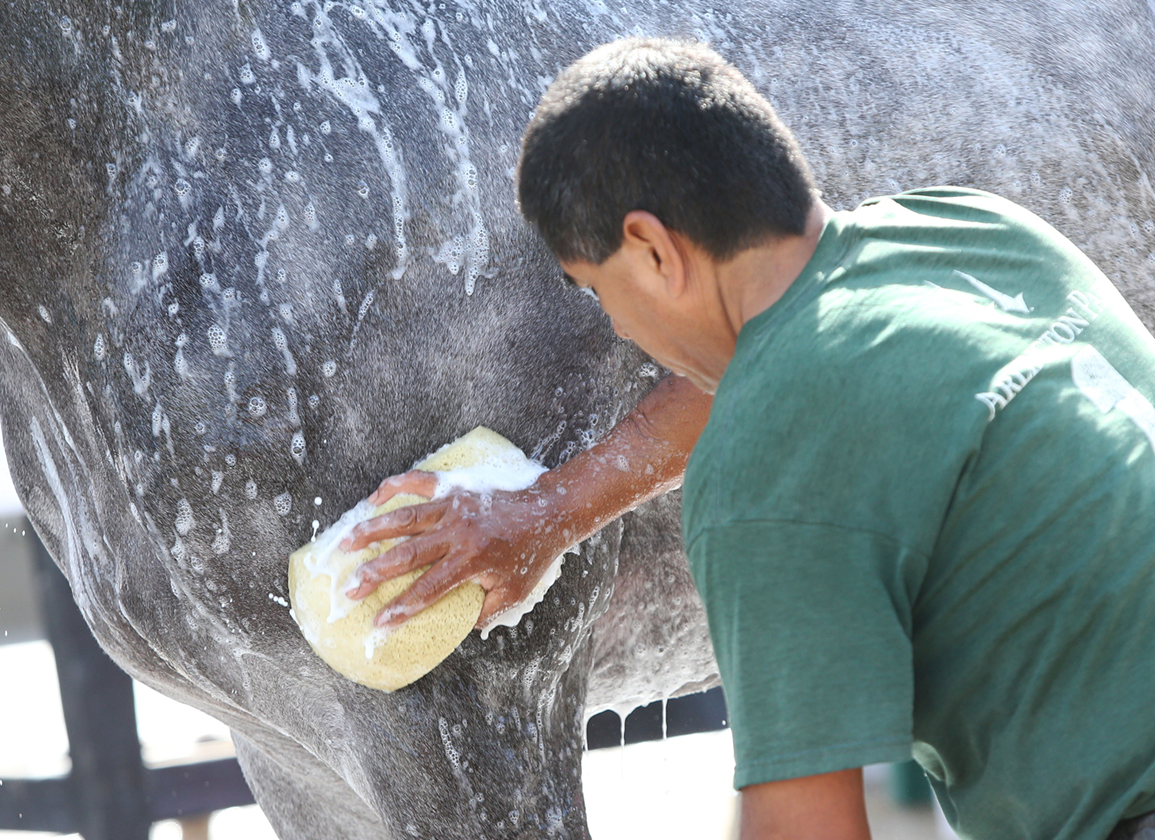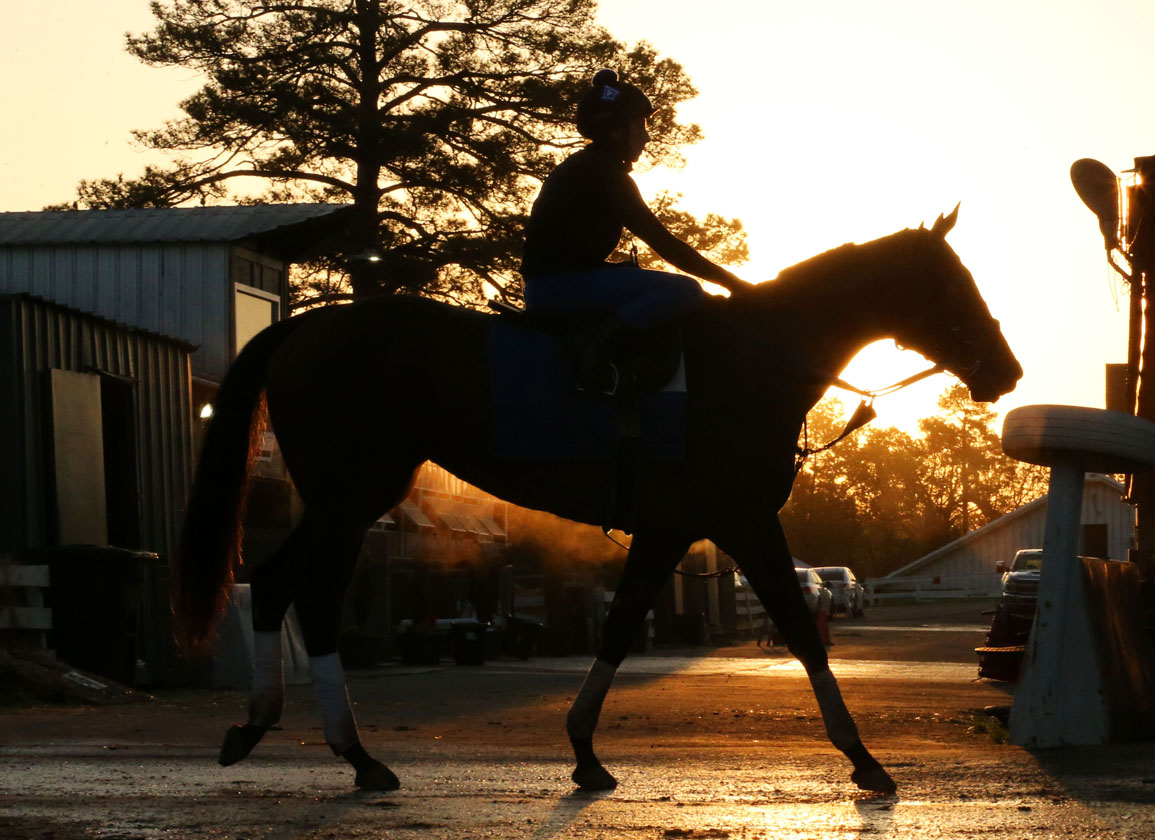Many across racing might be wondering how American horse racing under the Horseracing Integrity and Safety Authority (HISA) could change.
To date, there are many questions and relatively few answers.
But two recent interviews with Dr. Tessa Muir, director of equine science for the United States Anti-Doping Agency (USADA), offer a glimpse into a possible future for the sport.
The suggestions Muir makes, while understandably qualifying that it is far too early to assess USADA's exact role with HISA given the lack of a contract between the two and no rule base in place just yet, are concurrently exciting and ground-breaking for American racing.
While there is much to be determined, one thing is certain: if Muir's early suggestions are close to the reality of USADA's likely involvement as HISA's enforcement agent, American racing is due for seismic changes, even if those are not fully in place by July 2022 when HISA is due to launch.
The Thoroughbred Daily News published the first piece on Aug. 29. Dan Ross posed several thoughtful questions to Muir about USADA's role, a focus on adopting a transparent approach to testing and results, and how their execution of anti-doping measures in human sports might translate to racing.
“It's probably a little too early to delve into specifics. There are things we've discussed with the Authority. If you take USADA's example of what there is with human sports, you can search any individual athlete by name, and you can see how many times they've been tested within that breakdown.”
“You can also look to other racing jurisdictions where they already publish some of this data, such as in Racing Victoria. After the race day, they publish a report on what horses got tested, pre-race and post-race.”
Using the example of Melbourne Cup Day in 2020, blood was drawn from 38 horses before racing (to be analyzed after the race), urine was drawn from six more and post-race samples from every race winner, along with the second and third finishers in the big race.
As it stands in U.S. racing now, few stakeholders know which horses are tested, with the exception of race winners. A ledger of out-of-competition tests is not available. Muir gives the impression this will change under USADA's role in HISA.
“There's a need for transparency in competition–for race day and in the out-of-competition component. If you look at USADA's history, they've been huge advocates for transparency and for sharing testing data.
“If you look on their website, you can search for an individual athlete and see how many times they've been tested in a year or in a quarter, which I think is a really positive thing.”
“On the equine side, we definitely want to publish testing data. I think there's a balance–you want to publish and be transparent to the point it doesn't compromise the integrity of the independent testing program you've got in place.”
The status quo, however, has been far different.
In a recent court filing (see page 16 of the document), prosecutors from the Southern District of New York argued indicted Standardbred trainer Nick Surick entered horses in races where he believed post-race testing would not be done for substances which he used in his horses.
Natalie Voss from Paulick Report drew attention to transcripts in the recent filing which indicated the indicted trainers may have been tipped-off, regularly, by track security staff of possible searches.
Knowing which horses are tested, when and how often is a crucial step towards improving overall confidence in the sport.
Three days following the publication of Ross's Q&A with Muir, she outlined more of the possibilities in an interview with Ray Paulick, citing USADA's “whereabouts” program which requires human athletes to report their daily schedule, enabling doping control officers to locate them for out-of-competition testing.
This would revolutionize testing in American racing, and require tremendous administrative attention from trainers and their staffs. Muir's remarks on this topic, to Paulick, are below:
“The intent of the (federal law) is that horses are accessible at any time at any place from the point of their first workout until they retire from racing. In order to conduct that 'no-advance-notice' testing anywhere at any time, you need whereabouts information in order to find the horse.
“That really is a critical underpinning for prevention, deterrence and detection of misuse of substances. Whilst specifics of how that may look are currently not finalized, if you look at any good anti-doping program in the world, whereabouts is a really key component. And that requires locations, not just while horses are in training but when they are in other locations resting or pre-training.”
USADA's “Whereabouts Policy” details the degree of specificity required by human athletes to ensure they can be located for testing.
Athletes must submit accurate contact information, providing a full schedule including “each location where the Athlete will train, work or conduct any other regular activity (e.g. school), as well as the usual timeframes for such regular activities.” In addition, they must identify one hour each day between 5 A.M. and 11 P.M. “during which the Athlete will be available and accessible for Testing at a specific location.”
Complete details of every overnight location must be provided on a quarterly basis, delineated by day. Any amendments to these plans must also be filed. The Whereabouts Policy document notes:
“The athlete must provide sufficient information to enable a doping control officer to find the location, to gain access to the location, and to find the Athlete at the location. For example, declarations such as 'running in Rocky Mountain National Park' are insufficient.”
Failure to comply with USADA's entire “doping control process” for human athletes can lead to suspensions of up to four years “and other consequences.”
In 2013, track and field athlete Trey Downing was suspended for 18 months for failing to provide a sample at a doping control officer's request.
In December 2020, UFC athlete Yair Rodriguez was suspended for six months for violating the UFC's Anti-Doping Policy by accruing three “Whereabouts” failures in each of the first three quarters of 2020. According to the release of the sanction, “Rodriguez was eligible for a reduction in the period of ineligibility because his conduct did not raise suspicion that he was trying to avoid being available for testing.”
Introduction of such a policy across American racing is difficult to comprehend given the status quo and will leave HISA and USADA, not to mention trainers, with a mountain of administrative work to assure compliance over time.
The recently released transcripts of conversations from trainers Jorge Navarro and Jason Servis, as well as veterinarian Kristian Rhein and other indicted individuals highlight the importance of doping control agents having routine access to horses, and this includes knowing where all horses are supposed to be at all times. Navarro and Rhein both pled guilty in August and are due to be sentenced in December.
In one of the wiretapped calls from June 5, 2019, Servis tells Rhein that testers, presumably from the New Jersey Racing Commission, were looking for Sunny Ridge at Monmouth Park on June 3, more than a week after he won the Salvator Mile (G3) there. Servis told Rhein that the horse was not there, but at Belmont. He then wonders incredulously why the testers took a sample from a juvenile that had not run well.
Standardbred trainer Nick Surick hid horses to evade out-of-competition testing, according to a recent filing in the case by prosecutors. Paulick Report posted the full filing and it can be accessed here (Surick evasion details are on page 17 of the document).
Whereabouts policies, and penalties assessed for failures to comply with them, increase the difficulty of evading detection.
A national voice leading a unified effort to educate horsemen on a single set of rules has not been a feature of the American racing landscape.
New rules and new procedures will require outreach the likes of which the American racing industry has not witnessed previously. USADA offers a series of documents which outline the polices and procedures of their anti-doping control programs – some for athletes, coaches, health care professionals – and include details of testing and results management, rights and responsibilities, whereabouts and whistleblower policies, investigations principles and more.
Dr. Muir told Ross “the education component of any anti-doping and medication program is a foundation to the success of the program. There's a variety of ways to actually deliver that information in an effective way. Something we'll be looking to is [to have] a level of education in place ahead of the first of July 2022.”
While acknowledging that nothing has been developed as of yet given the lack of rules, USADA's expertise in communicating policies and procedures is well-established.
Muir acknowledged USADA is cognizant of the need to produce materials in Spanish and that outreach efforts goes well beyond just trainers.
“There are a lot of parties beyond just the trainers and the grooms who touch these horses on a day-to-day basis, and therefore, we want to be in the best position possible to give people the tools to comply with the rules.
When HISA begins to operate, with USADA as its expected enforcement agent, there is no expectation that all of the elements of the programs Muir outlined are fully operational.
“Achieving what she calls a 'gold standard' program will not happen overnight,” wrote Ray Paulick. “Muir puts an 18- to 24-month timeline on that goal.”
Among the education efforts, Muir notes that participation from the industry, including via anonymous tip lines, will be needed to supplement formal efforts to maintain an improved sport. A USADA-administered tip line won't be racing's first – but it will be the first under a new, unified rule set, and one run by an organization with actual, nationwide control.
“The testing investigations comes under the responsibility of the enforcement agency (presumably USADA), but the tip lines and other things must have industry ownership,” Muir said. “When it comes to the responsibility for clean racing and preventing, deterring and detecting people who might be doing the wrong thing, it's the responsibility of the whole industry to call that out and prevent it and to stand up for clean racing.”
Undoubtedly, the question of cost comes into consideration.
A robust approach to anti-doping efforts in American racing will be more expensive under HISA than the present. But Muir told Ross that the current state-by-state approach has made it challenging to understand how much is spent at present on these efforts, making future cost projections all the more difficult.
“I think one of the challenges at the moment is that there's not any one currently accepted understanding of what the total cost and total amount currently being spent is. So, getting a handle on that is quite difficult to know: How is it going to be more expensive, and by how much?
“As the [HISA] chairman [Charles Scheeler] alluded to at the [Jockey Club] Round Table, he said publicly that they anticipate the costs are going to go up, and of course, that's to be expected for an enhanced and more effective program of the scale we're looking at here.
“It's a comparatively small investment–I'm not saying it's necessarily a small amount of money, not to belittle the amount–but a comparatively small investment in protecting the fairness of clean racing for all our horsemen and obviously the health and welfare of the horses and the longevity of the sport in the future.”
The post TIF Examines Changes Suggested By Horseracing Integrity And Safety Authority appeared first on Horse Racing News | Paulick Report.





